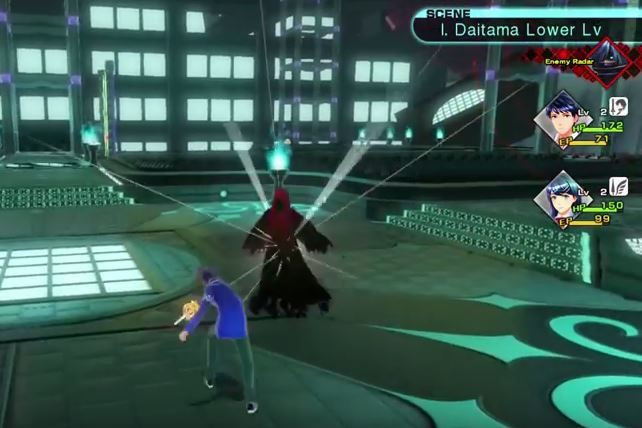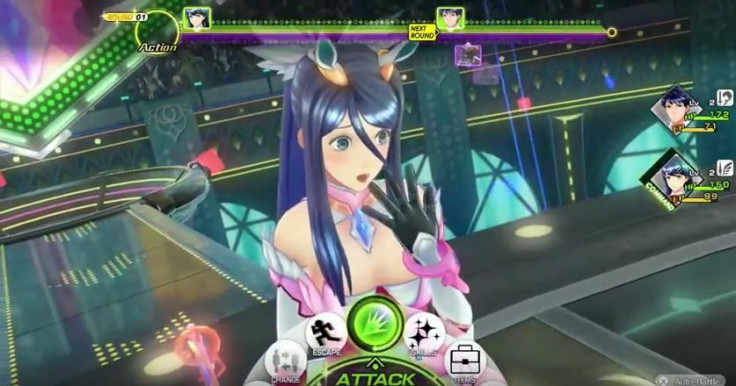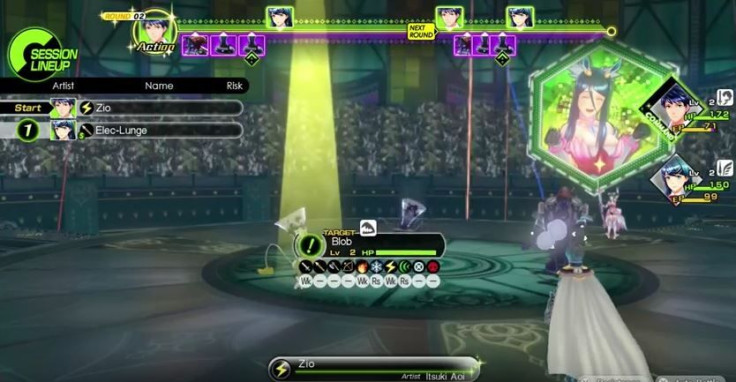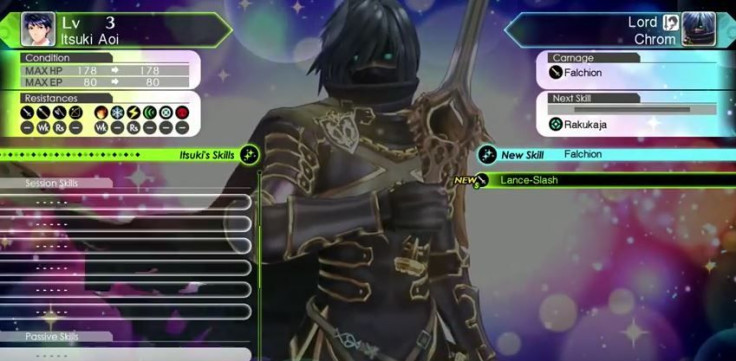Players will quickly learn that Tokyo Mirage Sessions #FE isn’t just music and anime-style drama. There’s a lot of fighting to be had within the dungeons (called Idolospheres) and you’ll want to learn how to defend yourself in the best way possible.
In this Tokyo Mirage Sessions #FE battle guide, we break down the basics of battling and how specific character traits affect combat.
So without further ado, let’s get right to it.
BASICS
Overworld:
When you first enter the Idolosphere, you’ll navigate through the dungeon to complete your goals. However, encounters within the Idolosphere are not random like in some other games.
Mirages will appear from the ground every so often to attack you. Chrom will let you know when a Mirage is nearby; this enemy radar can be found in the top right corner.

When the Mirages appear you can do a few things: You can run straight into them and begin a battle, you can strike them with your sword using the X button. A well-timed strike will incapacitate the Mirage allowing for you to either run away without a battle or to go into battle head-on (there’s a benefit to doing this and we’ll cover it a bit later).
Savage Encounters:
Most Mirages in the Idolosphere are cloaked in Red but you’ll eventually see Mirages that are completely dark purple. These are Savage Mirages, and if you engage them prepare for a much tougher battle.
Savage Mirages cannot be knocked away with your sword, so you need to either run away or prepare for a battle.
Turn Order:
Once you enter a battle, you’ll take the stage against a random number of enemies. You can only take three characters into battle at one time; once you get more, you’ll have to choose wisely.
The first thing you’ll notice is the turn order. This is indicated at the top of the screen. There are a number of factors that affect the turn order. If you attack a Mirage in the Overworld and run into it, more often than not you’ll have a First Strike! This allows for your entire team to attack for one full round before the real battle begins.

This is what you’ll want to try and achieve before each battle because if you get the first round, you can often decimate the team before they have a chance to launch a counterstrike.
If you encounter a Mirage without striking it, one of your characters will get the first attack and the rounds will begin as normal. However, if you are attacked from behind the enemy will get the first strikes, so always be vigilant.
Battle Options:
Once turn order is determined and it’s your first move, you’ll have plenty of options for your characters. You’ll notice on the right side of the screen are the active character icons. This tells you how much HP and EP you have left.
HP is, obviously, your health points while EP is your energy points. Every skill used needs EP so be sure to keep an eye on both.
However, when it’s time to choose an option in battle here are your choices and what you can do:
ESCAPE- This allows for your team a chance to escape a Mirage battle
ITEM - Use an item on a character, this ends your turn.
ATTACK - Attack using your weapon, this doesn’t use your EP but you can’t Session either.
SKILL - Use different skills gained by your character at the cost of EP
CHANGE - Once you have more than three characters, you can switch out one of them for a “Sub castmember.” Your main protagonist can’t Change.
GUARD - You can guard and take less damage from attacks this turn and you’ll gain some EP back.

Sessions:
When an enemy’s weakness is attacked with a skill, an ally who possesses a sessions skill corresponding to that skill will perform a follow-up attack. This is called a Session.
This is the most helpful part of battles, and will take some time to learn. You’ll want to strike enemies with attacks they are weak against; you can tell by an exclamation point that appears over its head. There will also be a chart below every enemy that will tell you if it’s Weak, Resistant or Neutral against each attack type.

Weapon types and Session Skills will be covered later on in the guide.
Overkill:
When an enemy’s remaining HP decreases to zero during a Session, an Overkill happens. The remaining attacks in that Session will ignore enemy’s resistances.
This is a great way to get more money and items. There’s also a special skill that your main character can learn that will change the target once the first enemy is killed and it’s VERY useful.
CHARACTERS
Now that the basics are out the way, let’s check out what makes the characters tick, starting with individual stats.
Stats:
Those familiar with the Fire Emblem series should recognize how character stats are divided out. Here is what each stat does:
STR = The strength affects damage the unit deals with physical attacks.
SPD = The speed stat affects a unit’s avoidance rate. It also allows a unit to strike twice if the speed stat has five more than the opponent.
MAG = The magic stat affects the damage from tomes.
LCK = The luck stat lowers the risk of enemy critical hits.
SKILL = This affects the hit rate and the frequency of critical hits.
DEF = The defense stat reduces damage from physical attacks.
RES = The resistance stat reduces the damage from magical attacks.

Every character’s stat increases are based on their class. Mages will have a high MAG and RES stat, normally, so be sure to check out each character’s strengths and weaknesses before throwing them into battle.
Stage Rank/Radiant Skills:
Stage rank signifies rank as an entertainer. It will increase the more he or she participates in combat including longer session chains. As rank increases, they will receive various benefits, including new Performa. Each stage rank will give new material for Radiant Skills.
Radiant Skills are kind of like passive skills that affect battle and the overworld. You’ll need to perform Radiant Unity to achieve the new skill which comes with the added benefit of not taking up a skill slot.
Some of these skills are necessary to progress through the story.
WEAPONS/SKILLS
Every character has a natural weapon they use along with different skills they can learn as they level up. Some of these skills have elemental properties that can affect your performance against specific enemies. You’ll need to become accustomed to the type charts to really become a Mirage Master.
Weapon/Elements:
Weapons and elemental attacks help determine weaknesses and resistances. Before we talked about a chart that appears below every enemy when you scroll over them. This chart shows what weapon types and element attacks an enemy is resistant and weak. However, if you haven’t met a particular enemy before, it will remain blank, so you’ll have to experiment and figure out what types work best against it.
The opposite can be said for your main character. You can check out what weapons and elements they are weak/resistant to in their profiles. The Sword, Axe, Lance triangle from Fire Emblem is implemented in this game, so if you can remember Sword > Axe > Lance > Sword, you’ll be fine.
Bane Skills:
Some weapons have special skills that only work on certain enemies. Like in Fire Emblem , a weapon that is effective against horseback enemies or flying enemies will always activate a session against that specific class.
Carnage Unity:
Weapons in Tokyo Mirage Sessions #FE are called Carnage and they help determine a character’s strengths and weaknesses. You can also create new Carnage through Carnage Unity that gives characters more strength and resistances to certain elements/weapons, not to mention access to new skills.
Each Carnage has a set number of skill (or inheritances) that it can learn. Once you’ve mastered a Carnage, switch it out and equip a new one to gain all of its skills.
Performa:
However, to create a new Carnage you’ll need to collect Performa, or an enemy’s essence after you defeat them. Tiki will show you what Performa you need to complete the Carnage Unity so be sure to defeat as many enemies as possible.
Skills:
The Carnage’s skills will boost your character’s repertoire.If you learn a skill you already have, it will power up. Example: Zio becomes Zio + 1.

When a skill powers up, it increases the effects or it can decrease the EP cost. Passives can’t power up, however.
Special Performances:
Special Performances are your character’s ultimate skill. These special skills use the SP Gauge located in the upper right of the screen. These can triggers sessions while ignoring affinities.
The SP Gauge will fill with every Session performed or various skills are executed.





![Best Gaming Mouse For Gamers With Smaller Hands [2025]](https://d.player.one/en/full/227430/best-gaming-mouse-gamers-smaller-hands-2025.png?w=380&h=275&f=fdcf47c1c5fc58d1e41d3be505c12568)












